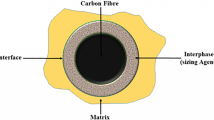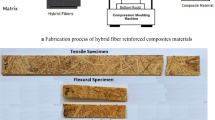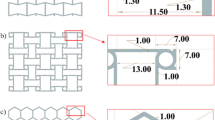Abstract
The automotive sector showed a great interest in the composite leaf spring as a substitute for steel springs due to high strength-to-weight ratios. The better mechanical properties, lower density, and manufacturing feasibility of composites in aviation, marine, and automotive industries also have a broad acceptance. The aim is to evaluate the effect of the leaf spring when the composite is applied as a substitution. This study observed static conduct for a composite leaf spring in comparison to that of a steel leaf spring concerning deformation, load-bearing, stresses, and weight savings. Deformation and stresses were taken as design constraints. The specification and dimensional were optimized using Taguchi’s technique. To study the static behaviour, Finite Element Analysis (FEA) is done using ANSYS workbench 19.2. To simulate operating conditions by modelling the Leaf spring in the 3-D modelling software SOLIDWORKS. To validate the results of the software, the results were compared to the numerical method. For the Design of Experiments (DOE), Minitab software was used. Moreover, the outcome of the study represents the performance of composite material in leaf spring along with the design optimization. The composite material was found to give better performance over conventional material. Furthermore, the stress-induced in it was minimum i.e., 448.32 MPa, 491.32 MPa, 488.32 MPa in carbon epoxy, S glass epoxy, and E glass epoxy compared to 496.98 MPa in plain carbon steel and the deformation was optimum. Also, the weight of the composite material is less i.e., 3.884 kg, 4.338 kg, 2.506 kg in S glass epoxy, E glass epoxy, and Carbon epoxy compared to 12.217 kg in plain carbon steel.















Similar content being viewed by others
References
Ke, J., et al.: A review on material selection, design method and performance investigation of composite leaf springs. Composite Struct. 111277. (2016)
Yu, W., Kim, H.: Double tapered FRP beam for automotive suspension leaf spring. Compos. Struct. 9, 279–300 (1988)
Kurmi, S., et al.: Design and static structural analysis of leaf spring using FEA. Int. J. Res. Appl. Sci. Eng. Technol. (IJRASET) (2018)
Chavhan, G., et al.: A review on stresses and displacement in leaf spring. Des. Aanal. Leaf Spring Using Composite Mater. (2018)
Jain, V., et al.: Analysis of leaf spring conditions for heavy duty vehicle, Research, and Development (IJAuERD) ISSN 2277–4785, 97–104 (2013)
Solanki, P., et al.: A review on composite material mainly use in leaf spring. Study Rev. Leaf Spring (2015)
Noronha, B., Yesudasan, S., Chacko, S.: Static and dynamic analysis of automotive leaf spring: a comparative study of various materials using ANSYS. J Fail. Anal. Preven. 20, 804–818 (2020). https://doi.org/10.1007/s11668-020-00877-y
Jamadar, N.I., Kivade, S.B., Tati, P.: Prediction of residual fatigue life of composite mono leaf spring based on stiffness degradation. J Fail. Anal. Preven. 18, 1516–1525 (2018). https://doi.org/10.1007/s11668-018-0548-8
Duan, L., Song, C., Yang, S., et al.: High-precision modeling and simulation of the taper leaf spring of tandem suspension of commercial vehicles. J Mech Sci Technol 30, 3061–3067 (2016). https://doi.org/10.1007/s12206-016-0614-7
Wu, Wj., Zhu, Lm., Yu, X. et al.: Novel method for equivalent stiffness and Coulomb’s damping ratio analyses of leaf spring. J. Mech. Sci. Technol. 26, 3533–3538 (2012). https://doi.org/10.1007/s12206-012-0866-9
Kim, B.M., Kim, J.W., Moon, I.D., et al.: Optimal combination of design parameters for improving the kinematics characteristics of a midsize truck through the design of experiment. J Mech Sci Technol 28, 963–969 (2014). https://doi.org/10.1007/s12206-013-1167-7
Aydin, E., Dutkiewicz, M., Öztürk, B., et al.: Optimization of elastic spring supports for cantilever beams. Struct Multidisc Optim 62, 55–81 (2020). https://doi.org/10.1007/s00158-019-02469-3
Krużelecki, J.: Parametrical optimization of compression helical springs against instability. Struct. Optim. 12, 135–141 (1996). https://doi.org/10.1007/BF01196947
Qin, Y., Wang, Z., Yuan, K., et al.: Comprehensive analysis and optimization of dynamic vibration-absorbing structures for electric vehicles driven by in-wheel motors. Automot. Innov. 2, 254–262 (2019). https://doi.org/10.1007/s42154-019-00079-9
Wang, L., Wang, Z.: Failure analysis of the longitudinal composite leaf spring. J Fail. Anal. Preven. 20, 1437–1444 (2020). https://doi.org/10.1007/s11668-020-00961-3
Hocine, A., Maizia, A., Chérifi, M., Chapelle, D.: A contribution of the reliability-based approach for a cylindrical composite of sensitivity analytical design. Adv. Mater. Process. Technol. 3(3), 428–437 (2017). https://doi.org/10.1080/2374068X.2017.1336883
Khatkar, V., Behera, B.: Experimental investigation of textile structure reinforced composite leaf spring for their cyclic flexural and creep behavior. Compos. Struct. 258, 113439 (2021). https://doi.org/10.1016/j.compstruct.2020.113439
Lakho, M., Bhatti, T., Rajpar, A., Khoso, M., Qazi, I.: Comparative tensile behavior study of locally developed jute reinforced composite materials with conventional composite materials. Adv. Mater. Process. Technol 4(3), 370–377 (2018). https://doi.org/10.1080/2374068X.2018.1440867
George, A., et al.: A review on hybrid composite material more efficient than steel. Des. Anal. Leaf Spring Hybrid Composite Mater. (2017)
Lakshmi, B., Satyanarayana, I.: Static and dynamic analysis on composite leaf spring in a heavy vehicle. Int. J. Adv. Eng. Res. Stud. (2012)
Al-Qureshi, H.: Automobile leaf springs from composite materials. J. Mater. Process. Technol. (2001)
Shokrieh, M., Rezaei, D.: Analysis and optimization of a composite leaf spring. Composite Struct. (2003)
Bulent, E.: Multi-response optimization in a three-link leaf-spring model. Int. J. Vehicle Des. (2005)
Talib, A., Ali, A., Goudah, G., Lah, N., Golestaneh, A.: Developing a composite based elliptic spring for automotive applications. Mater. Des. (2010)
Malaga, A., Charyulu, T., Ramesh, C.: Design optimization of leaf spring. Int. J. Eng. Res. Appl. (2012)
Venkatesan, M., Devaraj, D.: Design and analysis of composite leaf spring in light vehicle. Int. J. Modern Eng. Res. (2012)
Kueh, J., Paris, T.: Finite element analysis on the static and fatigue characteristics of composite multi-leaf spring. J. Zhejiang Univ. (2012)
Bakhshesh, M., Bakhshesh, M.: Optimization of steel helical spring by composite spring. Int. J. Multidiscipl. Sci. Eng. (2012)
Raghu, B., Vijaya, R., Ramesh, N.: Static analysis of mono leaf spring with different composite materials. J. Mech. Eng. Res. (2013)
Shivashankar, G., Vijayarangan, S., Rajiv, D., Pradeep, R.: Genetic algorithm based optimal design of mono composite leaf spring and testing.
Trivedi, A., et al.: Static and dynamic analysis of automobile leaf spring (TATA ACE). IJSTE: Int. J. Sci. Technol. Eng. pp. 2349–784X (2015)
Gaylo, R., Farahani, S., Schmueser, D., et al.: Optimization of a mono-composite leaf spring using a hybrid fibre-layup approach. Int J Interact Des Manuf 14, 407–421 (2020). https://doi.org/10.1007/s12008-019-00636-w
Pundir, R.,Chary, G., Dastidar, M.: Application of Taguchi method for optimizing the process parameters for the removal of copper and nickel by growing Aspergillus sp.. Water Resour. Ind. 20:83–92 (2018). https://doi.org/10.1016/j.wri.2016.05.001.
Mitra, A., Jawarkar, A., Soni, T., Kiranchand, G.: Implementation of Taguchi method for robust suspension design. Proc. Eng. 144, 77–84 (2016). https://doi.org/10.1016/j.proeng.2016.05.009
Tamizharasan, T., Senthilkumar, N., Selvakumar, V., et al.: Taguchi’s methodology of optimizing turning parameters over chip thickness ratio in machining P/M AMMC. SN Appl. Sci. 1, 160 (2019). https://doi.org/10.1007/s42452-019-0170-8
Ke, J., et al.: A review on material selection, design method and performance investigation of composite leaf springs. Compos. Struct. 226, 111277 (2019). https://doi.org/10.1016/j.compstruct.2019.111277
Zeng, D., Ethier, C.: A semi-torsional spring analogy model for updating unstructured meshes in 3D moving domains. Finite Elem. Anal. Des. 41(11–12), 1118–1139 (2005). https://doi.org/10.1016/j.finel.2005.01.003
Amalu, E., Ekere, N., Zarmai, M., Takyi, G.: Optimisation of thermo-fatigue reliability of solder joints in surface mount resistor assembly using Taguchi method. Finite Elem. Anal. Des. 107, 13–27 (2015). https://doi.org/10.1016/j.finel.2015.08.004
Berselli, G., Bilancia, P., Luzi, L.: Project-based learning of advanced CAD/CAE tools in engineering education. Int J Interact Des Manuf 14, 1071–1083 (2020). https://doi.org/10.1007/s12008-020-00687-4
Lafarge, B., Cagin, S., Curea, O., et al.: From functional analysis to energy harvesting system design: application to car suspension. Int J Interact Des Manuf 10, 37–50 (2016). https://doi.org/10.1007/s12008-015-0284-1
Khalkhali, A., Nikghalb, E., et al.: Multi-objective optimization of hybrid carbon/glass fibre reinforced epoxy composite automotive drive shaft. Int. J. Eng. Trans. A 28, 583–592 (2015). https://doi.org/10.5829/idosi.ije.2015.28.04a.13
Tamrakar, S.: Characterization of S-glass epoxy composite interface under various rates of loading, university of Delaware, (2018) http://udspace.udel.edu/handle/19716/23606
Ramakant, U., Sowjanya, K.: Design and analysis of automotive multi-leaf spring using composite material. IJMPERD2249–6890 3(1): 155–162 (2013)
Elsheltat, S., et al.: Modeling and finite element analysis of leaf spring using pro-engineer and ANSYS Softwares. In: Proceedings of First Conference for Engineering Sciences and Technology (CEST), September 25–27, (2018)
Bhandari, V.B.: Machine design data book. McGraw Hill (2019)
Author information
Authors and Affiliations
Corresponding author
Additional information
Publisher's Note
Springer Nature remains neutral with regard to jurisdictional claims in published maps and institutional affiliations.
Rights and permissions
About this article
Cite this article
Kushwah, S., Parekh, S., Mistry, H. et al. A methodological study of leaf spring by material comparison and Taguchi’s DOE. Int J Interact Des Manuf 16, 239–252 (2022). https://doi.org/10.1007/s12008-021-00831-8
Received:
Accepted:
Published:
Issue Date:
DOI: https://doi.org/10.1007/s12008-021-00831-8




